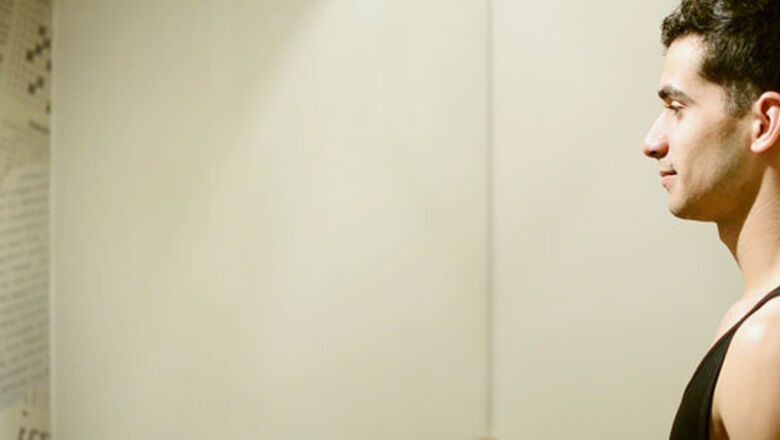
views
Scissors
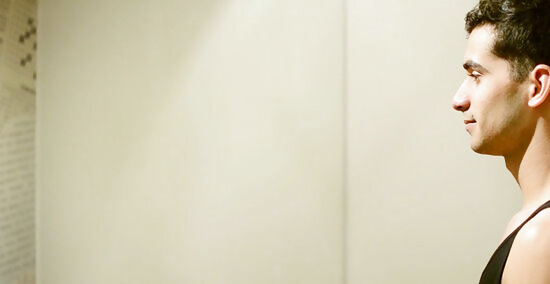
Stand in front of a well-lit mirror. Make sure that you have a place to dispose of the hairs that you snip--a sink, a waste bin, or a disposable towel will do. Make sure that the lights are bright enough to clearly see into your nostrils: good lighting helps you see the lighter hairs that may be sticking out of your nose. You may need to get close to the mirror to see enough detail. Try using a magnifying mirror or a hand-held mirror to get the right angle. Nose hairs may stick to the scissors as you trim, and you don't want to wipe them directly back into your nostril. Keep a tissue, napkin, or towel on hand to wipe the scissors down. If you have access to a sink, you can rinse the tweezers clean of any clinging hair after each snip.
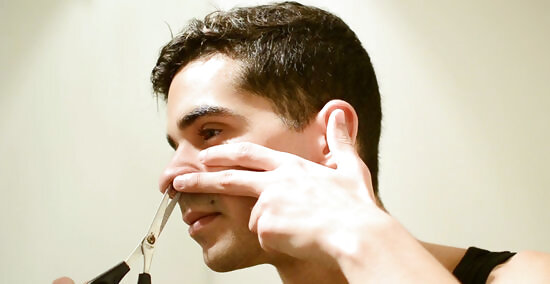
Snip the hairs that drive you crazy, but don't trim away everything. Try to snip only the most visible hairs: the hairs near the rim of your nostril, and any large hairs that noticeably protrude from your nose. Smile at yourself in the mirror--or push your nose straight up with your finger--to reveal nose hairs that don't poke out otherwise. Trim only what you absolutely need to trim. Your nose hairs serve an important function by protecting your body from infection, and removing nose hair completely could have negative side effects. Always use a sanitary pair of scissors. Avoid using wavy "craft scissors", as well as dull, rounded children's scissors. You don't want to wrestle with your nose hairs, nor accidentally pull them out; you want the trimming process to be as neat and as smooth as possible. Always clean the handles and blades of your scissors with water and antibacterial soap, and towel them dry before you use them. Consider using antiseptic to sterilize the scissors: if they have been used before, especially by other people, they might carry germs and bacteria that you don't want to inhale.
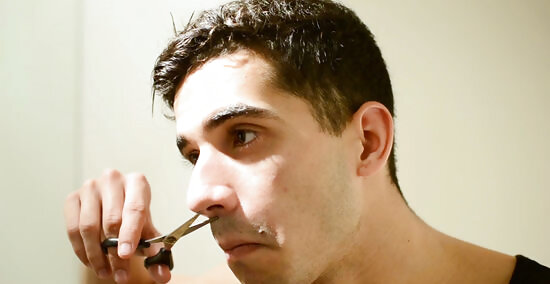
Carefully clip the longest protruding hairs. Line the tip of the scissors up with any thick bunches or particularly long hairs, make sure that your skin is clear of the blades, and snip with a gentle but decisive motion. Find the roots of the longest hairs, and trim them closely so they'll take longer to grow back. Only cut the hairs that people will notice: the hairs that stick out directly from your nose. Resist the urge to completely clear out your nostrils. Be gentle when sticking the scissors into your nasal canal. Never shove the trimming scissors into your nose: you can do a lot of damage--and put yourself at further risk of infection--if you slice open your nasal passage. Watch your hand and the scissors closely, even if the scissors are rounded at the tip. Trim until you're satisfied with your appearance. Smile at yourself in the mirror, again, and trim any hairs that stick out. If you look at yourself straight-on in the mirror and you can't see any obvious nose hairs, then you've probably done enough. Bear in mind that you may judge your appearance harshly than others do. Dispose of the nose hair trimmings as you go. Hairs may stick to the scissors blades. You can rinse the hairs down the drain with water, or you can wipe them off of the scissors with a tissue, napkin, or towel.
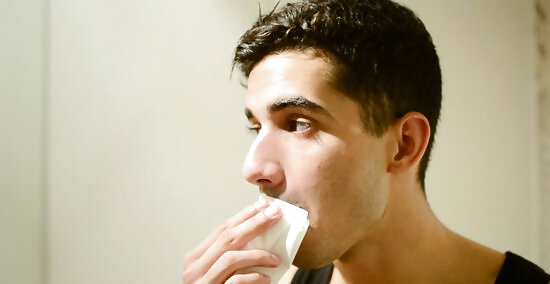
Clean up. Throw away your nose hair trimmings, or wash them down the drain. Blow your nose to expel any clinging hair trimmings--and consider cleaning out your nostril with a tissue, a sanitary wipe, or a nasal spray. Clean up any stray trimmings that have fallen onto the sink, the counter, or the floor. Wipe the scissors with antiseptic before you put them away, or at the very least wash them with soap and water. This is especially important if you used communal scissors: would you want to use scissors that had just been up someone's nose?
Nose Hair Trimmer

Stand in front of a well-lit mirror. Make sure that the lights are bright enough to clearly see into your nostrils: good lighting helps you see the lighter hairs that may be sticking out of your nose. You may need to get close to the mirror to see enough detail. Try using a magnifying mirror or a hand-held mirror to get the right angle. Keep a towel on hand to wipe your face when you're done, and keep tissues on hand to clean the trimmings out of your nostrils.
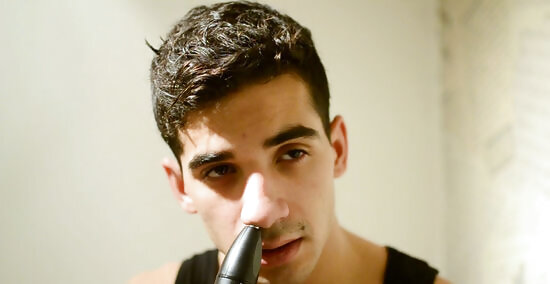
Buzz the hair that peeks out from your nostril. Tilt your head back and carefully insert the nose trimmer, looking into the mirror for accuracy. Try gently pulling down your upper lip to open up the nasal passage. The trimmer should fit comfortably; don't push it all the way in. Stir the trimmer in a slow circular motion, moving up and down the nostril. Your trimmer shouldn't hurt you or cut your skin--especially not an electric trimmer. The blades are covered such that they buzz nose hair close, but never actually touch the skin. Some trimmers, however--especially the manual variety--may occasionally (and painfully) yank a hair from the root. Be careful not to insert the trimmer too deeply in your nose. You only want to trim the hairs peeking out below your nose--the ones that people will notice. Leave the rest of the hair alone to help protect you from bacteria. Buzz until you're satisfied with your appearance. The trimming shouldn't take you long--perhaps only a matter of seconds. If you aren't sure, pull the trimmer from your nostril and inspect the situation in the mirror.
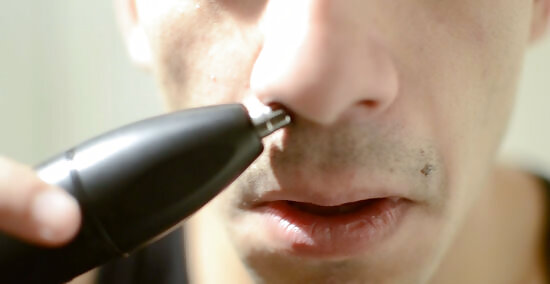
Trim the hairs that drive you crazy, but don't remove everything. Try to trim only the most visible hairs: the hairs near the rim of your nostril, and any large hairs that noticeably protrude from your nose. Smile at yourself in the mirror--or push your nose straight up with your finger--to reveal nose hairs that don't poke out otherwise. Trim only what you absolutely need to trim. Your nose hairs serve an important function by protecting your body from infection, and removing nose hair completely could have negative side effects.
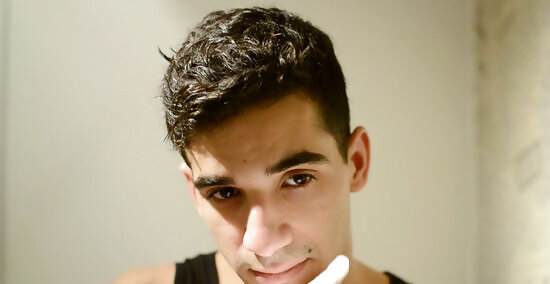
Clean up when you're finished. Clean the nose hair trimmer, clean your face, and wipe up any stray nose hair trimmings that have spilled onto the sink, the counter, or the floor. You can clean most manual nose hair trimmers by rinsing the blades with running water, but many electric trimmers are not wet/dry capable. Wipe an electric trimmer clean with a moist or dry towel, and be careful not to submerge it in water. Unplug or switch off electric trimmers before wiping them clean. Use a towel to wipe off any hair that's fallen onto your face. Lightly blow your nose into a tissue to catch any remaining trimmings--and consider cleaning out your nostril with a tissue, a sanitary wipe, or a nasal spray. Use a towel, tissue, or sponge to clean stray hairs from any surfaces. Dispose of your cleaning tool or wash it clean.

















Comments
0 comment